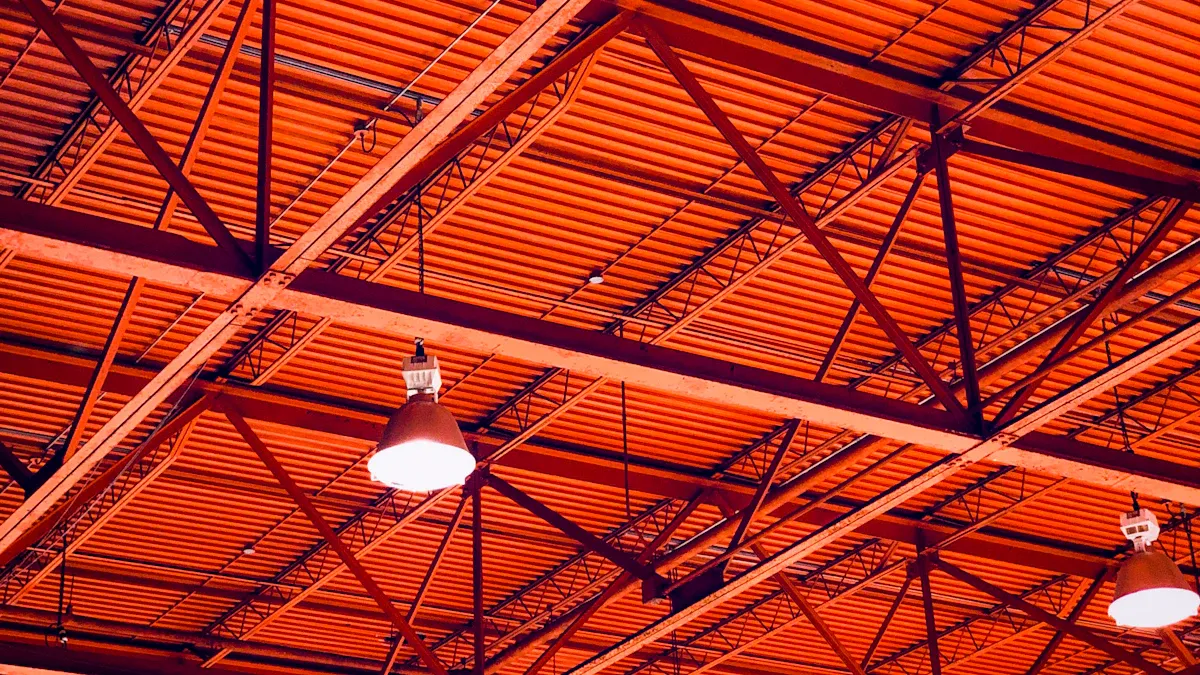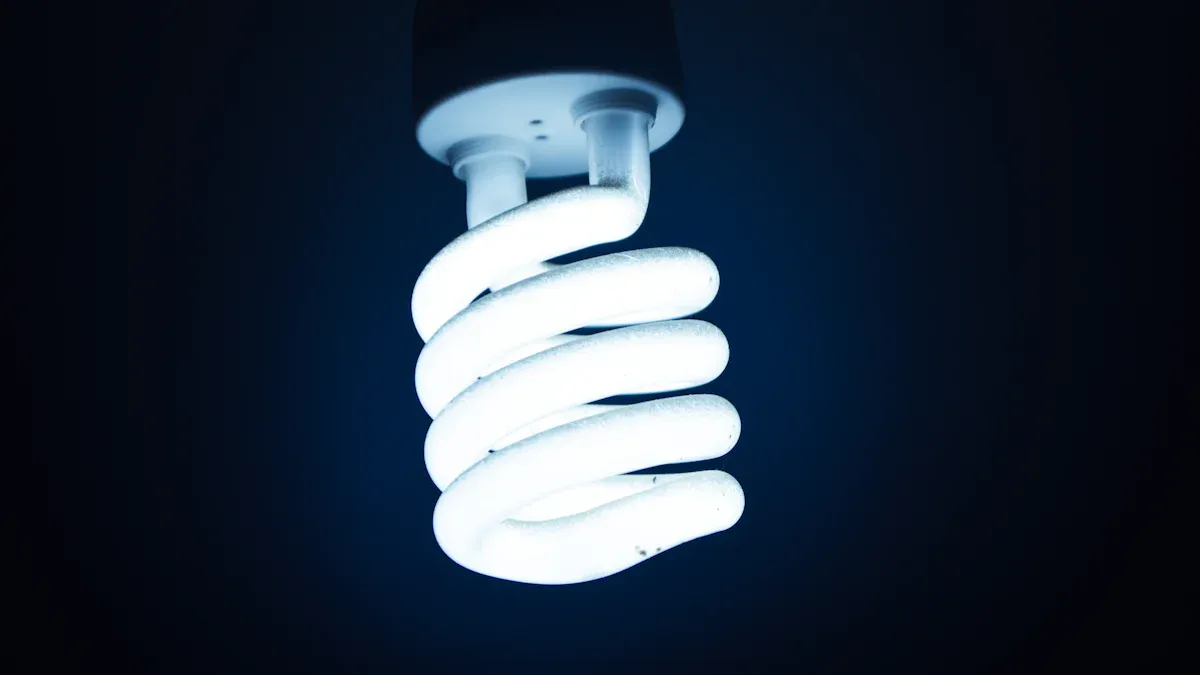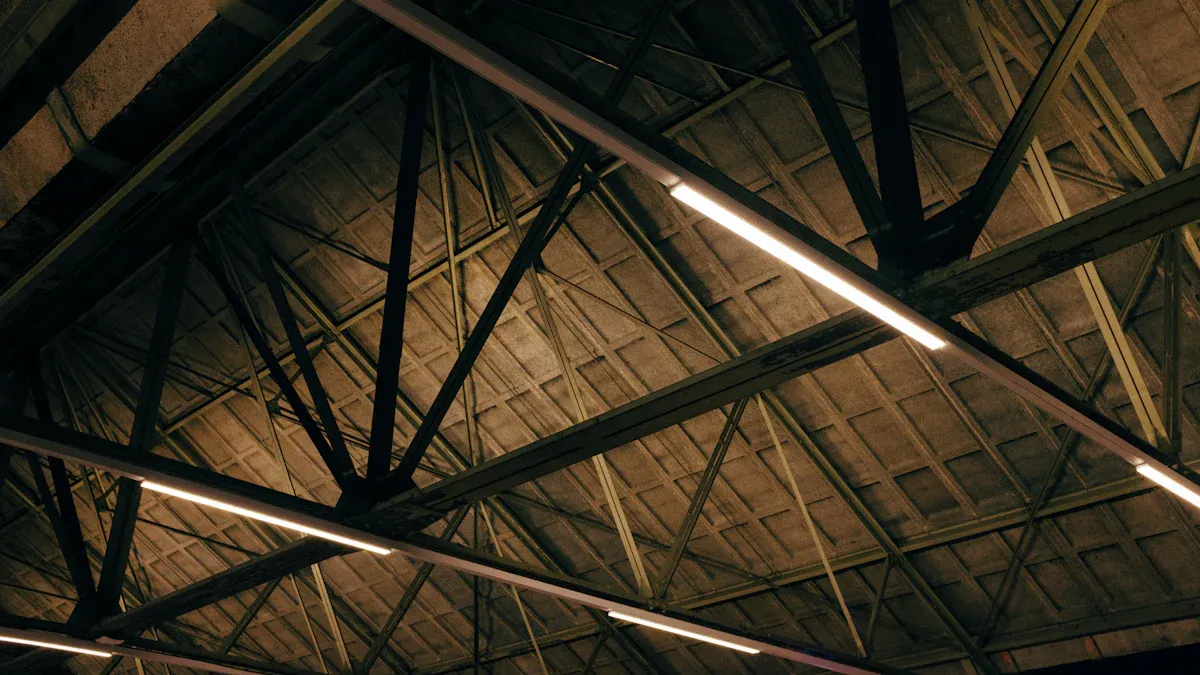Industrial LED Light Bulbs: Efficiency, Applications, and Selection

Industrial LED light bulbs have revolutionized lighting with improved energy efficiency. These bulbs consume up to 50% less power than traditional lights, significantly reducing energy bills. By switching to LED lights, you can save up to 80% on costs, while also benefiting the environment through lower energy consumption. Additionally, LEDs have an impressive lifespan, lasting up to 40 times longer than regular bulbs, which means fewer replacements and reduced expenses on maintenance. If you operate a warehouse, factory, or outdoor area, selecting the right lights, including options like solar light, is crucial for optimizing your business operations and maintaining an eco-friendly approach. For more information, feel free to check out the About Us section on our website.
Key Takeaways
Using industrial LED bulbs can lower energy costs by 75%. This saves a lot on electricity bills.
Industrial LEDs last 25 times longer than regular bulbs. This means fewer replacements and less maintenance.
Picking the right brightness and color is important. It helps keep workers safe and productive.
Choose bulbs with high IP ratings for outdoor or risky areas. This ensures they are strong and safe.
Good industrial LED bulbs may cost more at first. But they save money over time with less energy use and fewer replacements.
What Are Industrial LED Light Bulbs?
Industrial LED light bulbs are special lights made for tough jobs. They are built to save energy, last long, and give bright light. These bulbs work great in places like factories, warehouses, and big buildings. Unlike regular LED bulbs, industrial ones can handle rough conditions and still work well.
Key Features of Industrial LED Light Bulbs
Industrial LED light bulbs have unique features that make them better than old-style lights. These features help them work well in hard environments:
Key Feature | Description |
|---|---|
Energy Efficiency | Uses much less power, cutting down on energy costs. |
Durability | Lasts up to 25 times longer, even in tough conditions. |
Thermal Management | Keeps cool by releasing heat, making them last longer. |
Advanced Technology | Has smart controls, dimming, and sensors to save energy. |
Improved Lighting Quality | Gives bright, even light for better visibility and safety. |
These features make industrial LED light bulbs a smart and money-saving choice for businesses.
Differences Between Industrial and Standard LED Bulbs
Industrial LED light bulbs are different from regular LED bulbs in key ways. These differences make them perfect for heavy-duty use:
Energy Efficiency: Industrial LEDs use up to 75% less energy than old lights.
Durability: They last much longer, so you save on replacements.
Thermal Management: They stay cool, working well even in hot places.
Lighting Quality: They shine brighter and more evenly, improving safety.
Advanced Features: Many have smart controls, dimming, and quick-on features.
These differences show why industrial LED light bulbs are the best for tough jobs where reliability matters.
Efficiency of Industrial LED Light Bulbs

Energy Savings and Reduced Costs
Using industrial LED light bulbs can save a lot of energy. These bulbs use up to 75% less power than old lights. This means big savings on electricity bills for large spaces like factories. For example, one factory switched to LEDs and cut energy use by 50%. This helped them save a lot of money on costs.
You can save even more by using smart controls with LEDs. These systems adjust lights based on people or sunlight. This can boost energy savings to as much as 70%. Reports show that factories using LEDs with controls saved up to 50%, and sometimes even 70%.
Lighting Type | Energy Savings (%) |
|---|---|
Traditional Lighting | 0% |
LED without controls | Up to 50% |
LED with connected controls | Up to 70% |
Longevity and Durability in Industrial Settings
Industrial LED bulbs last much longer than regular ones. Old bulbs often break from heat or being turned on and off too much. LEDs are made to handle tough conditions and can last 25 times longer. This means fewer replacements and less hassle.
In factories, durability is very important. LEDs have special systems to stay cool and work well in hot places. Problems like breaking from heat or losing brightness happen less with LEDs.
Failure Type | Description |
|---|---|
Catastrophic Failure | Happens when turning lights on and off causes stress and damage. |
Parametric Failure | Happens when lights lose brightness or change color from heat. |
Environmental Benefits and Sustainability
Industrial LED bulbs are great for the environment. They use less energy, which lowers pollution. One LED light can cut carbon emissions by almost half a ton during its life. This makes them a smart choice for eco-friendly businesses.
LEDs also last longer, so there’s less waste from replacing them. They need less fixing, which helps the planet too. Smart controls make them even better by saving more energy and adapting to changes.
LEDs cut pollution more than old lights.
One LED light can lower carbon emissions by nearly half a ton.
Smart controls make LEDs even more eco-friendly.
By choosing industrial LEDs, you save money and help the environment.
Applications of Industrial LED Light Bulbs

Industrial LED light bulbs can be used in many places. They are strong and save energy, making them great for tough jobs. Below are some common ways they are used.
Warehouses and Storage Facilities
Good lighting is very important in warehouses. Bad lighting can cause accidents or mistakes. Industrial LED bulbs give bright and even light, helping workers see better. They also use less energy, which is helpful for big spaces needing long hours of light.
Motion sensors and dimming features are also useful. These let lights change based on how busy the area is. For example, lights can dim or turn off in quiet spots. This saves energy and keeps costs low while staying safe.
Factories and Manufacturing Plants
Factories often have hard conditions like heat and vibrations. Regular lights can break in these places. Industrial LED bulbs are made to handle these problems. They work well even in tough environments.
Bright and steady light helps workers do their jobs better. It lowers mistakes and makes the workplace safer. LEDs also stay cool, making the area more comfortable. This is helpful in places where machines make a lot of heat.
Outdoor Spaces and Parking Lots
Outdoor areas need strong and long-lasting lights. Industrial LED bulbs are great for these spaces. They give bright light that helps people see and feel safe. Unlike old lights, LEDs turn on right away, even in cold weather.
These bulbs save a lot of energy, which is good for lights that stay on all night. Many outdoor LEDs are made to handle rain, snow, and heat. Using LEDs can cut down on repairs and make outdoor areas safer.
Hazardous Locations and Specialized Environments
Some places need lights that can handle tough conditions. These areas might have flammable gases, dust, or strong vibrations. Safety is very important in such locations. Industrial LED light bulbs are made to work well in these challenging spots.
Tip: Look for certifications like UL or ATEX when buying lights. These prove the bulbs meet safety rules.
Industrial LED light bulbs are strong and built to last. They can handle shocks, vibrations, and very hot or cold temperatures. This makes them perfect for places like oil refineries, chemical plants, and mines. Unlike old bulbs, LEDs stay cool, lowering fire risks in flammable areas.
These bulbs also give bright and even light. This helps workers see clearly and avoid mistakes during detailed tasks. For example, in labs, good lighting helps safely handle delicate materials. LEDs last a long time, so you don’t need to replace them often in hard-to-reach places.
Many industrial LEDs have special features like explosion-proof designs and coatings that resist rust. These make them great for marine areas or offshore platforms. Some LEDs also have high IP ratings, protecting them from water and dust.
Using industrial LED light bulbs in hazardous areas boosts safety and cuts maintenance costs. Their energy-saving and long-lasting design make them a smart choice for tough environments.
How to Pick the Right Industrial LED Light Bulbs
Picking the right industrial LED light bulbs helps save money and energy. By checking things like brightness, color, and fixture fit, you can choose bulbs that work best for your needs.
Checking Brightness and Lumens
Brightness is very important in industrial spaces. Instead of looking at watts, check lumens, which show how bright the light is. For example, a big warehouse might need high-lumen bulbs to light up large areas.
Think about the size of the space and what happens there. A storage area may need 10,000 lumens for general lighting. A factory might need even brighter bulbs. Always read the lumen number on the box to match your needs.
Tip: Use a lumen calculator to find the right brightness. This tool helps avoid lights that are too dim or too bright.
Picking the Right Color Temperature
Color temperature changes how light looks and affects work. It’s measured in Kelvin (K) and goes from warm yellow to cool white. Cooler lights (4000K–6500K) are better for workspaces. They give clear light that helps people focus and reduces eye strain.
For example, a factory floor works well with 5000K lights. These lights look like daylight and make it easier to see. Warmer lights (2700K–3000K) are better for break rooms where people relax.
Note: Always pick a color temperature that fits the space’s purpose.
Making Sure Fixtures Fit
Before buying industrial LED light bulbs, check if they fit your fixtures. Look at the bulb’s base type, size, and voltage. Some fixtures need screw-in bases, while others use pin-based ones.
Also, check if your fixtures support dimming or smart features. Using the wrong bulbs can cause problems or damage. Always read the manufacturer’s guide to make sure the bulb fits.
Reminder: If you’re switching from old lights, you might need to update your fixtures for LEDs.
Understanding IP Ratings for Environmental Protection
When picking industrial LED light bulbs, it's important to know about IP ratings. These ratings show how well a light can block dust and water. The IP code, or Ingress Protection code, has two numbers. The first number tells how much it stops dust. The second number shows how well it handles water.
For instance, an IP65 bulb keeps out all dust and resists water sprays. This makes it great for outdoor areas or wet places. Meanwhile, an IP20 bulb gives basic protection and works best indoors in dry spots.
Tip: Match the IP rating to your space's needs. For wet or dusty areas, pick higher ratings like IP65 or IP67. For clean, dry spaces, lower ratings are fine.
Knowing IP ratings helps you choose bulbs that last longer and work better in tough conditions. It also keeps things safe and lowers repair costs.
Balancing Cost and Long-Term Value
Price matters when buying industrial LED light bulbs, but don’t just look at the upfront cost. LEDs might cost more at first, but they save money over time with their long life and energy savings.
For example, a good LED bulb can last 50,000 hours. A cheaper one might only last 10,000 hours. Replacing bulbs often adds to labor and material costs. Plus, energy-saving LEDs cut down on electricity bills, saving more money.
Note: Spending more on strong, high-quality bulbs reduces repair and replacement costs. This gives better value in the long run.
When choosing bulbs, think about the total cost. Check energy savings, how long they last, and how often they need fixing. Balancing these things helps you make a smart choice for your business.
Industrial LED Light Bulbs are very efficient, strong, and useful. They save energy, cut costs, and make places safer. Picking the right bulb for your needs is important. Think about how bright it is, its color, and if it can handle tough conditions.
Tip: Buying good-quality bulbs now can save money later and help the planet.
When you know your choices, you can set up lighting that helps your business and the environment.
FAQ
Why are industrial LED light bulbs better than old lights?
Industrial LED bulbs use less power and last much longer. They give brighter and steadier light, even in tough places. Unlike old lights, they handle heat, shaking, and frequent use well, making them great for industries.
Tip: Using LEDs can cut energy costs by up to 75%.
How can I pick the right brightness level?
Look at the lumens number on the bulb. More lumens mean brighter light. For big areas like warehouses, you might need 10,000 lumens or more. A lumen calculator can help you choose the right brightness.
Note: Don’t pick bulbs based on watts; focus on lumens instead.
Are industrial LED bulbs safe for risky areas?
Yes, many industrial LEDs are made for dangerous places. Check for safety labels like UL or ATEX. These show the bulbs are safe for spots with gases, dust, or shaking. They often have explosion-proof designs and strong IP ratings.
Reminder: Always check the bulb’s safety labels before buying.
Can I use industrial LED bulbs outside?
Yes, industrial LEDs work great outdoors. Pick bulbs with high IP ratings, like IP65 or IP67, to block water and dust. These bulbs also work well in extreme weather, perfect for parking lots and outdoor spaces.
Do industrial LED bulbs save money over time?
Yes! While they cost more upfront, industrial LEDs last longer and use less power. This lowers replacement and electricity costs. A good LED bulb can shine for up to 50,000 hours, saving you a lot of money.
Emoji Tip: 💡 Buy quality LEDs now to save money later!
See Also
Exploring GE LED Bulbs: Key Features And Selection Advice
The Journey Of General Electric LED Bulbs And Innovations
Understanding LED Replacement Lights: Varieties And Installation Benefits

